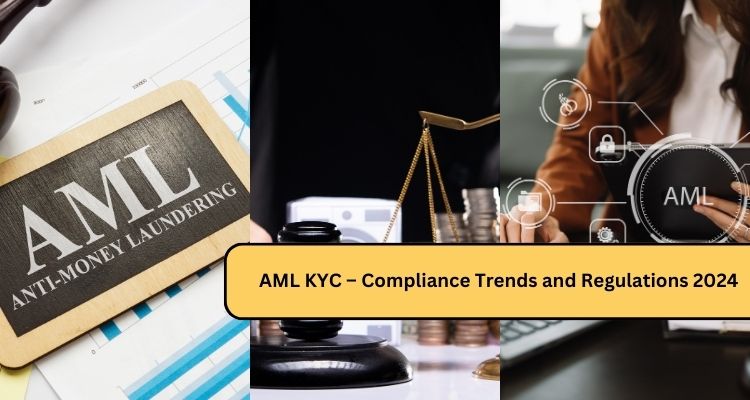The modern financial world is a complex ecosystem bustling with activity. While this facilitates commerce and growth, it also creates opportunities for malicious actors to engage in illegal activities like money laundering and terrorist financing. Robust AML KYC – Compliance Trends and Regulations 2024 are crucial to combat these threats.
This blog dives deep into the ever-evolving landscape of AML/KYC compliance in 2024. We’ll explore the key trends, emerging technologies, and critical regulatory updates shaping the financial landscape. Whether you’re a compliance professional, a risk manager, or simply interested in financial integrity, this blog will equip you with the knowledge and insights to navigate the changing tides of compliance.
Stay tuned as we unpack the intricacies of AML/KYC compliance in 2024, providing you with the tools and understanding to contribute to a more secure and transparent financial ecosystem.
Top Trends in AML/KYC Compliance for 2024
The evolving landscape of AML/KYC compliance demands dynamic strategies. Here’s a closer look at the key trends poised to shape the coming year:
1. Embracing the Risk-Based Approach:
Move over, one-size-fits-all KYC! 2024 embraces a risk-based approach, tailoring verification and monitoring efforts to individual customer profiles and transaction patterns. This means:
- Targeted screening: High-risk customers (e.g., politically exposed persons) face stricter scrutiny, while low-risk clients enjoy a streamlined process.
- Dynamic adjustments: Risk assessments adapt in real-time based on changes in customer behavior or market shifts.
- Scenario-based analysis: Identifying suspicious activity patterns specific to individual industries or geographic locations.
2. Tech Revolutionizing Compliance:
AI, machine learning, and big data analytics are no longer sci-fi; they’re transforming AML/KYC practices:
- Automated screening: AI algorithms scan vast databases for suspicious activity flags, significantly reducing manual workload.
- Transaction monitoring: Machine learning models identify anomalies in transaction patterns, pinpointing potential laundering attempts.
- Predictive analytics: Anticipating suspicious activity before it occurs, allowing proactive intervention by compliance teams.
3. Digital Identity Takes Center Stage:
The rise of digital wallets and decentralized finance (DeFi) demands innovative KYC solutions:
- Verifying digital identities: Exploring blockchain-based solutions and secure methods for verifying online credentials.
- Continuous monitoring: Tracking customer activity across platforms and ecosystems to ensure ongoing compliance.
- Balancing innovation with security: Integrating digital identity tools without compromising data privacy or vulnerability to cyberattacks.
4. Global Collaboration for Harmonization:
International cooperation is critical in fighting financial crime:
- FATF Travel Rule: This landmark initiative aims to track cross-border crypto transactions, enhancing transparency and accountability.
- Regional regulatory convergence: Efforts to streamline and harmonize AML/KYC regulations across jurisdictions are gaining momentum.
- Information sharing: Enhanced collaboration between regulators and financial institutions facilitates swift action against illicit activities.
5. ESG: Beyond Financial Crime to Ethical Conduct:
Environmental, social, and governance (ESG) factors are increasingly integrated into AML/KYC assessments:
- Combating greenwashing: Identifying individuals or businesses using false sustainability claims to mask illegal activities.
- Preventing human trafficking: Integrating measures to detect and disrupt financial flows linked to human exploitation.
- Promoting ethical practices: Ensuring financial institutions support sustainable and responsible activities through their compliance frameworks.
6. Enhanced Customer Experience: Balancing compliance with smooth onboarding and interaction is crucial. This includes:
- Streamlined KYC processes: Utilizing digital forms, pre-filled data, and automation to reduce friction and paperwork.
- Biometric verification: Implementing secure fingerprint or facial recognition for faster and more reliable identity confirmation.
- Personalized communication: Tailoring risk assessments and messaging to specific customer segments for a more relevant and engaging experience.
7. Continuous Monitoring and Real-Time Response: Static, one-time checks are being replaced by ongoing surveillance and dynamic adjustments:
- Transaction pattern analysis: Machine learning monitors customer behavior for sudden changes or deviations from established patterns, detecting potential risks quickly.
- Network analytics: Mapping connections between customers and entities to identify suspicious networks or clusters of illicit activity.
- Adaptive thresholds: Risk thresholds automatically adjust based on real-time market
- data and intelligence updates, ensuring optimal detection sensitivity.
8. Cybersecurity Fortification: As reliance on technology grows, so does the need for robust cyber defenses:
- Data encryption and secure storage: Implementing advanced encryption protocols and secure data storage solutions to protect sensitive customer information.
- Cybersecurity awareness and training: Educating employees and customers about cyber threats and best practices to prevent fraud and unauthorized access.
- Penetration testing and vulnerability assessments: Regularly testing systems for vulnerabilities and weaknesses to proactively address any security gaps.
9. Talent Acquisition and Development: Skilled compliance professionals are in high demand:
- Investing in training and education: Programs for upskilling existing staff and attracting qualified professionals with expertise in new technologies and evolving regulations.
- Collaboration with universities and industry organizations: Building partnerships to foster talent pipelines and develop the next generation of compliance experts.
- Promoting diversity and inclusion: Creating a diverse and inclusive workforce within compliance teams to ensure well-rounded perspectives and effective risk management.
10. Regulatory Technology (RegTech) Integration: Innovative technology solutions are streamlining compliance efforts:
- Cloud-based platforms: Centralizing data and processes on secure cloud platforms for improved accessibility and collaboration.
- Compliance automation tools: Automating repetitive tasks like regulatory reporting and data analysis to free up time for strategic analysis and risk assessment.
- Open-source intelligence (OSINT) platforms: Leveraging publicly available data to gain insights into customer behavior and identify potential risks from external sources.
These are just a few of the top trends shaping AML/KYC compliance in 2024. By staying informed and adapting to these changes, we can collectively build a more secure and ethical financial landscape.
Critical Regulatory Updates for 2024
As the financial world evolves, so do the regulations designed to combat financial crime. 2024 promises a dynamic regulatory landscape, with several key updates impacting AML/KYC practices globally. Here’s a closer look at some of the most significant changes:
1. EU’s Sixth Anti-Money Laundering Directive (6AMLD):
- Effective June 3, 2024: 6AMLD expands the scope of AML/KYC regulations to cover virtual assets (cryptocurrencies) and crypto asset service providers (CASPs).
- Enhanced customer due diligence (CDD): Stricter requirements for identifying and verifying beneficial ownership of legal entities, trusts, and foundations used for crypto transactions.
- Travel Rule implementation: Requires CASPs to record and transfer sender and recipient information for crypto transactions exceeding €1,000, enhancing transparency and traceability.
2. FinCEN’s Corporate Transparency Act (CTA) Beneficial Ownership Rule:
- Effective January 1, 2024: US companies must report beneficial ownership information to FinCEN, including name, date of birth, address, and percentage ownership.
- Impact on financial institutions: Banks, insurers, and other financial institutions must collect and verify beneficial ownership information from new and existing customers as part of their CDD procedures.
- Increased transparency: Aims to combat shell companies and financial crime by making ownership structures more transparent.
3. FATF Revised Recommendations:
- Ongoing adoption: Revised FATF Recommendations focus on areas like crypto assets, terrorist financing, and proliferation financing.
- Risk-based approach emphasis: Reinforces the importance of implementing a risk-based approach to AML/KYC, tailoring verification and monitoring efforts to individual risks.
- Global focus on information sharing: Encourages increased cooperation and information sharing between jurisdictions to combat cross-border financial crime.
4. Regional Regulatory Actions:
- Asia-Pacific: Jurisdictions like Singapore and Australia are implementing stricter AML/KYC regulations for virtual assets and digital payments.
- Latin America: Brazil and Mexico are strengthening their AML frameworks to address increasing concerns about illicit activity in the region.
- Middle East and Africa: Countries like the UAE and Kenya are also taking steps to enhance their AML/KYC regimes and comply with international standards.
5. United Kingdom:
- The Economic Crime (Transparency and Enforcement) Act 2022: Introduced a new register of overseas entities owning UK property, requiring disclosure of beneficial owners to combat money laundering through real estate.
- The Financial Conduct Authority (FCA): Increased focus on AML/KYC compliance for fintech firms and cryptocurrency businesses, with stricter registration and supervision requirements.
6. Canada:
- The Proceeds of Crime (Money Laundering) and Terrorist Financing Act (PCMLTFA): Updated in 2023 to expand its scope to cover virtual asset service providers (VASPs) and introduce new reporting requirements for large cash transactions.
- The Financial Transactions and Reports Analysis Centre of Canada (FINTRAC): Enhanced its focus on monitoring cryptocurrency transactions and collaborating with international partners to combat cross-border financial crime.
7. Singapore:
- The Payment Services Act (PSA) was amended in 2023 to strengthen AML/KYC requirements for digital payment token (DPT) service providers, including customer identification, transaction monitoring, and suspicious activity reporting.
- The Monetary Authority of Singapore (MAS): Actively exploring the use of blockchain and distributed ledger technology (DLT) for regulatory compliance and financial crime prevention.
8. Australia:
- The Anti-Money Laundering and Counter-Terrorism Financing Act 2006 (AML/CTF Act): Expected to undergo further amendments in 2024 to address emerging risks, such as the use of cryptocurrencies for illicit purposes.
- The Australian Transaction Reports and Analysis Centre (AUSTRAC): Expanding its regulatory reach to cover designated non-financial businesses and professions (DNFBPs), such as lawyers, accountants, and real estate agents, to combat money laundering risks in these sectors.
9. International Cooperation:
- The Egmont Group: A global network of financial intelligence units (FIUs) is working to enhance information sharing and coordination to combat cross-border financial crime.
- The Wolfsberg Group: An association of global banks is developing industry-led guidance for AML/KYC best practices in emerging areas like crypto assets and decentralized finance.
These examples demonstrate the ongoing evolution of AML/KYC regulations worldwide. Financial institutions and businesses must stay informed of these developments and adapt their compliance frameworks accordingly to effectively mitigate risks and protect the financial system’s integrity.
AML KYC Challenges and Opportunities
The complex tapestry of AML/KYC compliance in 2024 presents daunting challenges and exciting opportunities. While navigating this ever-shifting landscape, financial institutions, regulators, and individuals must contend with intricate obstacles while grasping the potential for improved efficiency, robust security, and a fairer financial system.
Challenges loom large:
1. Resource Constraints: Implementing robust AML/KYC requires manpower, technology, and expertise, often beyond the reach of smaller institutions. The struggle to secure adequate resources can lead to compromised compliance procedures and increased vulnerability to financial crime.
2. Data Privacy Concerns: Striking a balance between effective KYC verification and robust data protection is a delicate dance. Balancing compliance demands with customer privacy necessitates innovative solutions and ethical frameworks to foster trust and mitigate privacy risks.
3. Technology Adoption Hurdles: Integrating cutting-edge technologies like AI and blockchain into existing systems can be a complex and costly endeavor. Legacy infrastructure struggles to accommodate the agility and scale demanded by emerging technologies, posing a significant impediment to progress.
4. Regulatory Fragmentation: Navigating a patchwork of international and regional regulations creates confusion and compliance complexity. The lack of harmonization across jurisdictions hinders effective cross-border cooperation and leaves loopholes for criminals to exploit.
5. The Evolving Threat Landscape: As criminals adapt their tactics, AML/KYC frameworks must be equally dynamic. Emerging trends like DeFi, cryptocurrencies, and new typologies of financial crime necessitate continuous learning and adaptation from compliance professionals.
Despite these challenges, opportunities glimmer on the horizon:
1. Enhanced Efficiency and Cost Savings: Technological advancements like automation and predictive analytics promise to streamline KYC processes, reduce manual workload, and optimize resource allocation. By focusing on risk-based approaches, institutions can prioritize resources towards high-risk customers, resulting in cost savings and improved efficiency.
2. Improved Risk Management: AI and machine learning offer unparalleled capabilities for analyzing vast datasets and identifying anomalies in real-time. This translates to enhanced risk detection and prevention, ultimately safeguarding the financial system from illicit activities.
3. Collaborative Innovation: Open innovation, partnerships, and industry-wide knowledge sharing can accelerate the development and adoption of effective AML/KYC solutions. Collaboration among regulators, financial institutions, tech companies, and academia fosters a holistic approach to tackling complex challenges.
4. Global Harmonization: Increased international cooperation and efforts towards regulatory convergence offer hope for a more streamlined and effective AML/KYC landscape. Harmonized regulations simplify compliance burdens, improve cross-border collaboration, and close loopholes exploited by criminals.
5. A More Inclusive Financial System: Robust AML/KYC practices can ultimately contribute to a fairer and more inclusive financial system. By tackling financial crime and ensuring trust in institutions, we can create an environment where everyone has the opportunity to participate and prosper.
The challenges and opportunities presented by AML/KYC compliance in 2024 paint a dynamic picture. While daunting obstacles exist, the potential for progress and positive change is equally immense. By embracing innovation, fostering collaboration, and prioritizing both security and ethical principles, we can collectively navigate this intricate landscape and build a more secure and inclusive financial future for all.
How can you stay informed?
Staying updated on the ever-evolving world of AML/KYC compliance is crucial for financial institutions, risk management professionals, and anyone concerned about financial crime. Here are some valuable resources to help you stay ahead of the curve:
1. Regulatory Bodies:
- Financial Action Task Force (FATF): The global AML/CFT standard-setter, providing guidance and resources on best practices and emerging threats.
- Financial Crimes Enforcement Network (FinCEN): The US Treasury Department’s bureau is responsible for implementing AML/CFT regulations in the US.
- Europol: The European Union’s law enforcement agency, offering analysis and reports on European financial crime trends.
- Your Local Regulatory Authority: Check your local regulator’s website for updates on national AML/KYC regulations.
2. Industry Associations:
- ACAMS: The Association of Certified Anti-Money Laundering Specialists, offering professional development and certification programs for AML/KYC professionals.
- The Wolfsberg Group: A global association of banks developing industry-led guidance for AML/KYC best practices.
- Basel Institute on Governance: A non-profit organization promoting financial stability and integrity, offering research and resources on AML/CFT topics.
3. News and Publications:
- Reuters AML Hub: Provides news, analysis, and insights on global AML/KYC developments.
- AML Daily: Daily news digest of AML/KYC news and regulatory updates.
- Compliance Week: Provides news and analysis on regulatory compliance across various industries, including AML/KYC.
4. Online Resources:
- World Bank Financial Integrity: Offers data, research, and tools on anti-money laundering and financial crime prevention.
- United Nations Office on Drugs and Crime (UNODC): Provides resources and data on global crime trends, including financial crime.
- KYC Global Technologies: Offers a comprehensive database of global AML/KYC regulations and compliance requirements.
5. Webinars and Events:
- Many organizations and conferences host webinars and events on AML/KYC topics, keeping you up-to-date on the latest trends and best practices.
Staying informed is just one piece of the puzzle. Implementing best practices, building a strong compliance culture, and collaborating with others are vital for effectively combatting financial crime.
Expert Corner
The intricate symphony of AML/KYC compliance in 2024 demands both vigilance and hope. We stand at a crossroads where formidable challenges like resource constraints and regulatory complexity threaten to impede progress. Yet, amidst these obstacles, opportunities bloom. Technological advancements and collaborative efforts hold the potential to streamline processes, enhance risk management, and ultimately build a more secure and inclusive financial future.
Let us embrace the journey, navigating the challenges with determination and grasping the opportunities with innovation. Together, we can ensure that the melody of financial integrity resonates strongly in the year to come.



